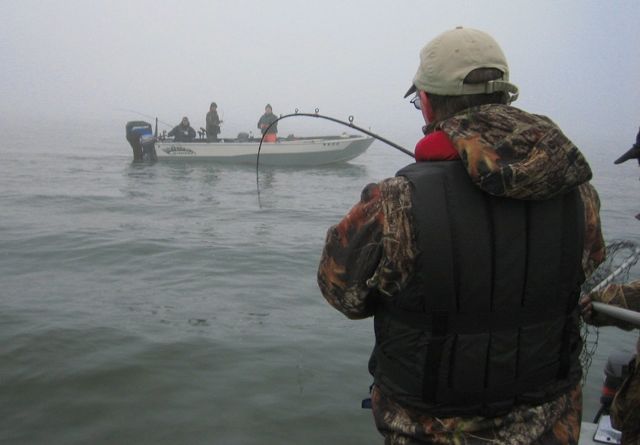forum
library
tutorial
contact

Anglers Finding Success for
Spring Chinook in the Columbia
by Mark Yuasa
Seattle Times, April 1, 2016
|
the film forum library tutorial contact |

|
Anglers Finding Success for
by Mark Yuasa
|
 "There are quite a few spring chinook being caught in the Lower Columbia mainstem," said Joe Hymer, a state Fish and Wildlife biologist. "Fishing improved in the Vancouver area, and around Cathlamet has been good in recent days as well as some fish caught in the Gorge area already."
"There are quite a few spring chinook being caught in the Lower Columbia mainstem," said Joe Hymer, a state Fish and Wildlife biologist. "Fishing improved in the Vancouver area, and around Cathlamet has been good in recent days as well as some fish caught in the Gorge area already."
Spring chinook heading back now to the Columbia River are creating a sport-fishing frenzy.
"There are quite a few spring chinook being caught in the Lower Columbia mainstem," said Joe Hymer, a state Fish and Wildlife biologist. "Fishing improved in the Vancouver area, and around Cathlamet has been good in recent days as well as some fish caught in the Gorge area already."
The upriver-bound spring chinook numbers are also on the rise, Hymer noted, with some dandy-sized fish up to 30 pounds.
Angler effort and catch rates picked up on the Lower Columbia with 14,517 angler trips taken this past week, and anglers had 1,288 adult spring chinook kept and 194 released, plus 77 hatchery steelhead kept and 46 released. Based on visual sampling, the upriver-bound fish comprised 55 percent of the kept catch.
The Lower Columbia is open daily through April 9 -- except April 5 -- from Buoy 10 up to Beacon Rock, plus bank fishing only from Beacon Rock up to the Bonneville Dam deadline. The daily limit is two salmon, and only one may be hatchery-marked chinook.
This comes on the heels of a Columbia forecast of almost 300,000 spring chinook (188,800 are upriver-bound adult fish) compared to last year's forecast of 232,500 and an actual return of 289,000.
This spring's forecast would rank as the ninth largest dating to 1990, if it comes in as predicted. The record return was 541,000 in 2001 (364,600 was the forecast), and the worst was 12,792 (12,000) in 1995.
The catch expectation this season is about 9,100 adult spring chinook (7,130 upriver spring chinook mortality) for the Lower Columbia fishery, and 900 adult fish for the season above Bonneville Dam.
An estimated 40,946 angler trips taken from Feb. 1 to March 27 has generated a catch of 2,211 adult spring kings (about 1,000 were of upriver origin) and 374 steelhead kept, and 303 adult chinook and 377 steelhead released.
Last year, 151,173 angler trips were taken with 19,586 spring chinook kept and 5,052 released. The fishery was open 74 of 107 days from March 1 to June 15.
While the lower river spring chinook catch has started off well, the peak return for upriver-bound fish doesn't occur until late April or early May.
"The fish are stalling out like they did five years ago, and just aren't crossing over Bonneville at a very fast clip," Hymer said. "Otherwise, the lower-river stocks (mainly bound for Willamette or Cowlitz) are on track or a little early."
Through March 29, 166 spring chinook had passed through the Bonneville fish counter, and the 10-year average is 277. Last year by this time it was 1,259 fish, although the water is much cooler this spring and could be delaying passage.
The Columbia River from the Tower Island power lines (about six miles below The Dalles Dam) to the Oregon-Washington border, plus the bank area between Bonneville and Tower Island power lines is open daily through May 6.
Some tributaries such as the Wind, Drano Lake and Klickitat are open for spring chinook, but don't produce good catches until late April through May.
On an interesting side note, many of the fish caught in the Lower Columbia have a more pale flesh than is normally seen, and fishery managers attribute it to what they ate in the ocean.
"The fish may have relied on forage fish like anchovy or herring rather than shrimp, krill or crab spawn," Hymer said. "It is a little more prevalent this year than in past years."
Lower river spring chinook stocks tend to reside much of their life off Oregon, Washington and Vancouver Island, and might have been challenged on what they ate in relation to the "Blob" (a large mass of warm water) that has affected some marine sea-life survival.
"The upriver fish we've seen have a nice red-meat look to them, and they go quite a ways offshore and may not have been affected by the food chain," Hymer said. "As of now the upriver fish are looking really healthy, and showing up in good numbers."
Fishery managers will reconvene on April 7 to review the ongoing fisheries, and could consider an extension if they see a stronger-than-expected return.
learn more on topics covered in the film
see the video
read the script
learn the songs
discussion forum
